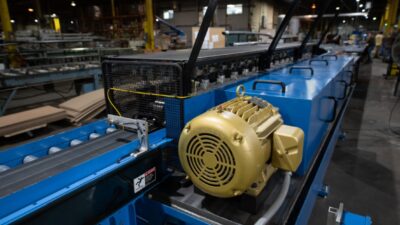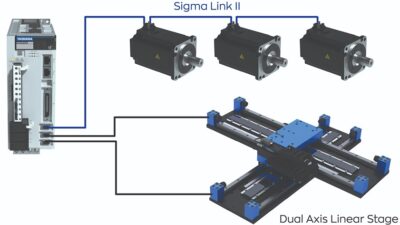Given that the bulk of electricity generated in the U.S. comes from burning fossil fuels, electric power consumption of any kind causes emissions of greenhouse gasses (GHGs). Wastewater facilities use electricity in all parts of the process, including offices, but the largest consumers are electric motor-driven pumps.
Given that the bulk of electricity generated in the U.S. comes from burning fossil fuels, electric power consumption of any kind causes emissions of greenhouse gasses (GHGs). Wastewater facilities use electricity in all parts of the process, including offices, but the largest consumers are electric motor-driven pumps.
Wastewater pumps housed in lift stations and elsewhere in treatment facilities require substantial amounts of energy to operate. Since water is intrinsically heavy, pumping it uphill or against a pressure gradient consumes large amounts of energy.
For instance, the Inland Empire Utilities Agency operates a moderate size, 8.5 million gallons per day (MGD) wastewater treatment plant in Ontario, CA. The facility’s total combined 1195 horsepower for all pumps as of 2001 consumed approximately 4,750,000 kWh of electricity annually. Using the U.S. Department of Energy’s (DOE) figure of 1.345 lbs of CO 2 emitted per kWh, operation of the pumps in this single facility for one year emitted approximately 3,200 tons of CO 2 , which is equivalent to traveling about 7 million miles in a vehicle at 20 miles per gallon.
A pump’s primary job is lifting and moving water, and most of the energy consumed is used to do that. But a pump also wastes considerable amounts of energy to overcome friction and vibrational forces within the motor and pump mechanism, as well as the turbulence and friction as water passes through the pump and pipelines.
The wire-to-water efficiency of a pump describes the amount of energy that a pump uses specifically for moving water, versus energy used wastefully to overcome friction, vibration, and turbulence. As efficiency increases, more of the energy applied to a pump is transferred into moving water. Therefore, by increasing pump efficiency, doing the same amount of work takes less energy, reducing GHG emissions and energy costs.
As an example, the wastewater treatment plant in Ontario, CA, mentioned above was part of a joint study with the California Energy Commission and the DOE. By conducting an energy efficiency study of the plant’s 19 water pumps, the plant’s operators found that only three of the most frequently maintained pumps had good wire-to-water efficiencies, approaching 70%. All others operated between 47% and 60% efficiency.
After replacing worn parts, including eddy current clutches and old motors, the plant reduced its energy consumption by about 10%, or 475,000 kWh per year, saving enough money on electricity to repay the repair cost in two years and reduce annual GHG emissions by about 320 tons.
This example is not unique. DOE studies indicate that increasing pump efficiency can realistically save up to 20% of the total energy consumed during wastewater pumping. Several case studies also support this claim for water pump stations in general, including an efficiency study and retrofit at Austin Energy in Austin, TX, where strategic upgrades annually saved 43,000 tons of CO2 emissions and $1.2 million in energy costs for pumping cooling water. Another study and upgrade project at Boise Paper in Wallula, WA, saved an estimated 330 tons of CO2 emissions and $17,500 in energy costs annually.
Why do pumps lose efficiency?
The table lists typical causes of efficiency losses that generally happen in various combinations. They can be split into two categories: mechanical degradation and ineffective operation.
Mechanical degradation, such as declining wear rings, loss of impeller clearance, or enhanced wear from buildups, requires ongoing pump and facility maintenance to correct and ensure maximum efficiency. Perhaps most critical to reducing the effects of wear is maintaining the internal wearing ring clearance and the smoothness of impeller and casing waterways. Sustaining the highest efficiency means maintaining pumps and all system components in virtually new condition.
Ineffective pump operation may be a result of pumps that are oversized for the job, selected and applied improperly, operated in a throttled condition to compensate for being oversized, careless management of system flows and pressure, pumping systems with bypass flow, use of multiple pumps systems where excess pressure is generated, using high system pressure instead of a booster pump, or changes from initial design conditions, such as cross connections, parallel main lines, or changes in pipe diameter or material.
Evaluation requires data
Solving pump efficiency problems requires a two-pronged approach. The first relates to physical changes, or pump selection and maintenance issues. This involves choosing the right type and size of pump for every application and keeping it in tip-top running condition. The second involves more subtle control and monitoring issues.
Pump maintenance has been treated extensively elsewhere, so we will concentrate on basic selection, control, and monitoring issues. When beginning an efficiency evaluation program, one of the most daunting issues is the simple question, where to start? When faced with the complex network of pumps, lift stations, pipelines, and other collection and treatment facilities associated with wastewater treatment answering that question becomes a key issue.
It is common in wastewater facilities for several individual pumps or pump stations to operate with high or relatively high efficiency, while the remainder—sometimes only a handful—operate at low or extremely low efficiency. This results in excess power consumption for the facility as a whole, and raises the problem of how to identify the problematic components. Without performance data for each pump station or pump in your facility, it is nearly impossible to make cost-effective or time-effective decisions regarding maintenance or replacement.
Evaluating the performance of a given pump requires extensive data history, including flow rates, water volumes, electrical consumption, running hours, and other variables that can help identify efficiency problem areas. Without such information, making future selections of the most efficient pumps and pump configurations is not possible.
Filling in that data and monitoring the system on an ongoing basis requires a basic package of instrumentation common to process industries. For example, parameters such as flow rate and energy consumption, if monitored consistently, provide the data needed to make basic efficiency calculations and identify problem equipment. Over time, data collected by ongoing pump and pump station monitoring could be used select and configure replacement hardware.
Fortunately, advances in flow and efficiency monitoring technology can significantly streamline the monitoring process. For instance, pump station manager packages are now available that include many built-in features that log level, pressure, energy usage, flow rates, and system efficiency data. These systems should interface with larger distributed control and data acquisition systems to support comprehensive reporting as well as real-time data, empowering operations staff to optimize the network on a short-term and long-term basis. Well-configured systems can also include algorithms that select and use the most efficient pump based on operational levels.
While monitoring instrumentation and pump station managers require up-front investment, life-cycle studies have shown that for wastewater pumps and lift stations, equipment capital cost for efficiency improvements are quickly offset by energy savings. For example, the “Causes of centrifugal pump efficiency losses” graphic shows that increasing the efficiency of a single, 100 hp pump by 20% can result in an annual savings of 145,000 kWh of electricity with a cost of $11,600, and 98 tons of CO 2 equivalent GHG emissions. These numbers speak for themselves: investing in pump efficiency reduces GHG emissions and saves money. ce
Source : Control Engineering with information from McNally Institute and RSE Consulting.
• Cavitation
• Degradation of wear rings
• Water hammer
• Operating at critical speed
• Pressure surges
• Increased internal recirculation
• Foreign objects
• Loss of proper impeller clearance
• Impeller imbalance or wear
• Eroded or corroded internal pump passages
• Bent shaft
• Over-lubricated or over-loaded bearings
• Harmonic vibration
• Buildups that may rub along mechanical seals
• Clogged pipelines or pumps
• Impeller and casing wear causing increased clearances
• Loose hardware
• Over-tightened packing or improper seal installation
• Use of vortex pumps
• Solids rubbing against components, especially the seal
• Shape of the impeller
• Operating too far from the pump’s best efficiency point
• Improperly managed hourly, daily, or monthly increases/reductions in flow/pressure
6 cents per kWh
8 cents per kWh
10 cents per kWh
12 cents per kWh
Source: Control Engineering with data from U.S. Department of Energy and RSE Consulting.
100 HP Pump
kWh required
726,000
726,000
726,000
726,000
Electricity cost
$43,600
$58,000
$72,600
$87,120
Tons GHG emissions
488
488
488
488
100 hp pump with 20% increase in efficiency
kWh
580,800
580,800
580,800
580,800
Electricity cost
$34,880
$46,400
$58,080
$69,696
Tons GHG emissions
391
391
391
391
Savings with 20% percent efficiency increase
kWh
145,200
145,200
145,200
145,200
Electricity cost
$8,720
$11,600
$14,520
$17,424
Tons GHG emissions
98
98
98
98
Author Information
Robert Eckard is principal, RSE Consulting. Reach him at [email protected] .



